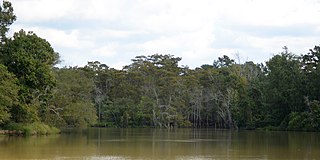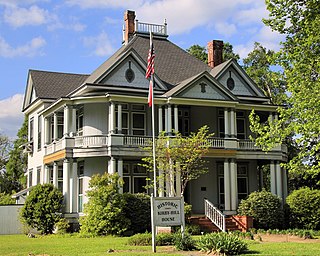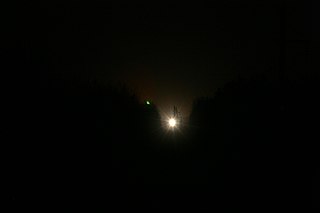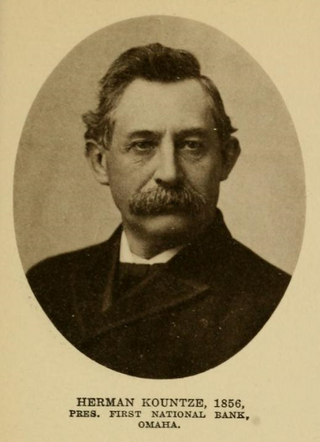Gallery
- Entrance of the "Ghost Road" of Hardin County TX
- Bragg Road of Hardin County, Texas (looking south)
- Bragg Road of Hardin County, Texas (looking north)
- Bragg Station, Texas where GCSF railroad used to run south to Saratoga.
The Light of Saratoga is a legend located in the Big Thicket of Southeast Texas. This legend of a mysterious light is also known as the Ghost Road of Saratoga, the Saratoga Light, and Bragg Light by local residents. Located on a dirt road, it is a light that may appear and disappear at random during the dark of night without explanation.
There are different beliefs as far as what the ghostly light could be, such as swamp gas and similar natural occurrences. The most popular story surrounding this legend is that a railroad worker was decapitated in a railway accident, and the light is that of his lantern as his ghost searches endlessly for his head. [1]
Two similar phenomena are the Paulding Light in Michigan's Upper Peninsula just north of Watersmeet and the Maco light in south-eastern North Carolina. Coincidentally, the same story of a headless railroad conductor also is offered as the explanation for these mysterious lights.
Located in Texas between Beaumont and Livingston, approximately 16 miles west of Kountze, Texas. [2] The dirt road runs north–south starting at the south end at a bend on Farm-to-Market Road 787 that is 1.7 miles north of the intersection of FM 787-770, near Saratoga and ending at the north end at Farm-to-Market Road 1293 near the ghost town of Bragg Station. [3] The cause of the light has not been established but one common explanation is that the light is the result of car lights from a nearby highway, however the light is usually seen when facing north and the highway can only be seen while facing south.
In 1902, Gulf, Colorado and Santa Fe Railway hacked a survey line from Bragg to Saratoga, bought right-of-way and opened the Big Thicket forest with a railroad, and the Saratoga train began its daily trips to Beaumont, carrying people, cattle, oil and logs. When the area's oil booms and virgin pine gave out, road crews pulled up the rails in 1934, the right-of-way was purchased by the county and the tram road became a county road.

The Neches River begins in Van Zandt County west of Rhine Lake and flows for 416 miles (669 km) through the piney woods of east Texas, defining the boundaries of 14 counties on its way to its mouth on Sabine Lake near the Rainbow Bridge. Two major reservoirs, Lake Palestine and B. A. Steinhagen Reservoir are located on the Neches. The Angelina River is a major tributary with its confluence at the north of Lake B. A. Steinhagen. Tributaries to the south include Village Creek and Pine Island Bayou, draining much of the Big Thicket region, both joining the Neches a few miles north of Beaumont. Towns and cities located along the river including Tyler, Lufkin, and Silsbee, although significant portions of the Neches River are undeveloped and flow through protected natural lands. In contrast, the lower 40 miles of the river are a major shipping channel, highly industrialized, with a number of cities and towns concentrated in the area including Beaumont, Vidor, Port Neches, Nederland, Groves, and Port Arthur.

Hardin County is a county located in the U.S. state of Texas, United States. As of the 2020 census, its population was 56,231. The county seat is Kountze. The county is named for the family of William Hardin from Liberty County, Texas.

Kountze is a city in and the county seat of Hardin County, Texas, United States. The population was 1,981 at the 2020 census. The city is part of the Beaumont–Port Arthur Metropolitan Statistical Area.

Sour Lake is a city in Hardin County, Texas, United States. The population was 1,773 at the 2020 census. It was originally named "Sour Lake Springs", after the sulphurous spring water that flowed into the nearby lake. The city is part of the Beaumont–Port Arthur Metropolitan Statistical Area. Sour Lake is the oldest surviving town in Hardin County. It is called by some the "Gateway to the Big Thicket".

Southeast Texas is a cultural and geographic region in the U.S. state of Texas, bordering Southwest Louisiana and its greater Acadiana region to the east. Being a part of East Texas, the region is geographically centered on the Greater Houston and Beaumont–Port Arthur metropolitan statistical areas with a combined population of 7,662,325 according to the 2020 U.S. census.

The Marfa lights, also known as the Marfa ghost lights, have been observed near U.S. Route 67 on Mitchell Flat east of Marfa, Texas, in the United States. They have gained some fame as onlookers have attributed them to paranormal phenomena such as ghosts, UFOs, or will-o'-the-wisp. Scientific research suggests that most, if not all, are atmospheric reflections of automobile headlights and campfires.

The Piney Woods is a temperate coniferous forest terrestrial ecoregion in the Southern United States covering 54,400 square miles (141,000 km2) of East Texas, southern Arkansas, western Louisiana, and southeastern Oklahoma. These coniferous forests are dominated by several species of pine as well as hardwoods including hickory and oak. Historically the most dense part of this forest region was the Big Thicket though the lumber industry dramatically reduced the forest concentration in this area and throughout the Piney Woods during the 19th and 20th centuries. The World Wide Fund for Nature considers the Piney Woods to be one of the critically endangered ecoregions of the United States. The United States Environmental Protection Agency (EPA) defines most of this ecoregion as the South Central Plains.

The Big Thicket is the name given to a somewhat imprecise region of a heavily forested area of Southeast Texas in the United States. This area represents a portion of the mixed pine-hardwood forests of the Southeast US. The National Park Service established the Big Thicket National Preserve (BTNP) within the region in 1974 and it is recognized as a biosphere reserve by UNESCO. Although the diversity of animals in the area is high, with over 500 vertebrates, it is the complex mosaic of ecosystems and plant diversity that is particularly remarkable. Biologists have identified at least eight, and up to eleven, ecosystems in the Big Thicket area. More than 160 species of trees and shrubs, 800 herbs and vines, and 340 types of grasses are known to occur in the Big Thicket, and estimates as high as over 1000 flowering plant species and 200 trees and shrubs have been made, plus ferns, carnivorous plants, and more. The Big Thicket has historically been the most dense forest region in what is now Texas.

The Spooklight is a ghost light reported to appear in a small area known locally as the "Devil's Promenade" on the border between southwestern Missouri and northeastern Oklahoma, west of the small town of Hornet, Missouri. It is caused by the misidentification of distant car headlights.
Bragg is a ghost town in Hardin County, Texas, United States, in the Big Thicket forest area of the southeastern part of the state. Sometimes referred to as "Bragg Station", this small community that flourished in the early 1900s lies ten miles west of Kountze.

The Beaumont–Port Arthur metropolitan statistical area is defined by the United States Census Bureau as a three-county region in Southeast Texas. The metropolitan area shares borders with the Houston–The Woodlands–Sugar Land metropolitan area to the west and the Lake Charles metropolitan area in the U.S. state of Louisiana to the east. The area is also known as the Golden Triangle. The "golden" refers to the wealth that came from the Spindletop oil strike near Beaumont in 1901, and "triangle" refers to the area among the cities of Beaumont, Port Arthur, and Orange.
The Maco Light was a supposedly anomalous light, or "ghost light", occasionally seen between the late 19th century and 1977 along a section of railroad track near the unincorporated community of Maco Station in Brunswick County, North Carolina. Said to resemble the glow from a railroad lantern, the light was associated with a folk tale describing a fatal accident, which may have inspired tales of a similar type around the country.
Saratoga is an unincorporated community in Hardin County, Texas, United States. It is located approximately 26 miles (42 km) northwest of Beaumont and adjacent to the Big Thicket National Preserve. The ZIP code is 77585.

The Paulding Light is a light that appears in a valley outside Paulding, Michigan. Reports of the light have appeared since the 1960s, with popular folklore providing such explanations as ghosts, geologic activity, or swamp gas.
Kountze Park is an urban public park located at 1920 Pinkney Street in the Kountze Place neighborhood of North Omaha, Nebraska, in the United States. The Park is historically significant as the site of the Trans-Mississippi Exposition of 1898.
Ghost light or ghostlight may refer to:

Herman Kountze was a powerful and influential pioneer banker in Omaha, Nebraska, during the late 19th century. After organizing the Kountze Brothers Bank in 1857 as the second bank in Omaha, Herman and his brothers Augustus, Charles and Luther changed the charter in 1863, opening the First National Bank of Omaha that year. Kountze was involved in a number of influential ventures around Omaha, including the development of the Omaha Stockyards and the Trans-Mississippi and International Exposition of 1898. Immediately after his death Kountze was regarded as one of Omaha's "old settlers". Today Kountze's First National Bank is the oldest bank west of the Mississippi River, and continues as a privately held company in its sixth generation of family ownership.
Augustus Kountze was an American businessman based in Omaha, Nebraska, Kountze, Texas and New York City. He founded a late 19th-century national banking dynasty along with his brothers Charles, Herman and Luther.

Pine Island Bayou is a tributary of the Neches River located in southeast Texas. It runs about 55 miles from the northwest corner of Hardin County, Texas and flows in a southeastern direction through western Hardin County, turning east and defining the southern Hardin and Jefferson County boundary for about 20 miles until its confluence with the Neches River. Two significant tributaries of Pine Island Bayou are Mayhaw Creek and Little Pine Island Bayou. The lower ten miles of Pine Island Bayou and much of Little Pine Island Bayou are protected from development in the Big Thicket National Preserve. Excluding the last few miles north of Beaumont, the area is not densely populated, and some small towns include Sour Lake and Saratoga, the latter the birthplace of country singer George Jones.

Turkey Creek is a stream in Texas, United States. It rises in Central Tyler county and flows 30 miles (48 km) before converging with Village Creek, east of Kountze, Hardin County. It passes through the 8,032-acre (3,250 ha) Turkey Creek Unit of the Big Thicket National Preserve on its way south.